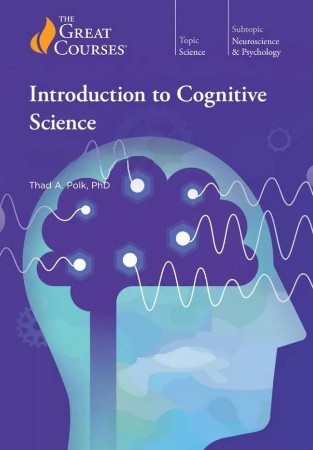Most Commented
TTC Video - Introduction to Cognitive Science




Description material

TTC Video - Introduction to Cognitive Science
.MP4, AVC, 1280x720, 30 fps | English, AAC, 2 Ch | 13h 3m | 10.82 GB
Lecturer: Thad A. Polk, Ph.D. Professor, University of Michigan | Course No. 10360
For millennia, philosophers and scientists have been trying to unlock the secrets of the mind with only limited success—until now. Today, with modern technologies, including the best in neuroscience, medical imaging, and recent advances in artificial intelligence, we are making more progress than ever before.
In Introduction to Cognitive Science, Professor Thad A. Polk takes you on a fascinating tour of the latest discoveries in the relatively new field of cognitive science. The goal is nothing less than understanding every interaction working in the human brain to produce all forms of cognition. Computer scientists, engineers, linguists, physicians, psychologists, and more are all pursuing the mysteries of the most complex structure in the known universe: the human brain.
But how do we learn about the mechanisms underlying human cognition? Unlike scientists studying other parts of the body, hands-on examination of the brain yields limited results. We can certainly learn about the brain's structure, but where is the "thinking"? How can we best use our mind to learn about the mind?
In 24 exciting lectures, Professor Polk will share dozens of the most challenging questions in cognitive science today: How do humans process language? How do we make decisions, and why do we so often regret them later? What are emotions, and why do we feel them? How does the brain affect our visual perception of the world? In this course, Professor Polk gives the latest, exciting answers for these questions, and many more.
Getting around the Black Box
Since we cannot directly see how the objective, measurable activity in the brain becomes our subjective world, scientists often describe the mind as hidden in a "black box." Cognitive scientists use a variety of interdisciplinary methods to get around this fundamental problem. In Introduction to Cognitive Science, you'll learn about contributions from:
- Psychologists. Beginning in the 1980s, research psychologists began using violation-of-expectation experiments with infants and young children, discovering that the children had a much deeper understanding of the world at an earlier age than we realized.
- Neurologists/Neurosurgeons. Scientists would like to know more about how the brain represents the sounds of human speech. Recent studies by neurosurgeons implanting electrodes in the left temporal lobes of epilepsy patients showed that specific populations of neurons respond to very specific sounds of human speech.
- Artificial Intelligence (AI) Engineers. Recent developments in AI such as convolutional neural networks and generative pretrained transformer (GPT) models provide new tools for cognitive scientists to better model and investigate brain functions, including visual perception, language, and reasoning.
Join In the Experiments Yourself
In this course, you'll participate in some fascinating experiments. It's one thing to learn from lectures or books about different types of memory, for example, but in this course, you will learn firsthand аbout:
- Expectations and Perception. We assume that we see the reality of the world around us, but that is just not the case. In this exercise, you'll realize how significantly your expectations and assumptions influence what you see. Looking at a picture of dents and bumps on the side of a battleship, you'll discover that your perception is controlled by your unacknowledged assumption that the light source is at the top of the picture. But even when you're made aware of that assumption, it feels impossible to change that expectation.
- Working Memory. This is the memory you use to remember something for a short period of time for a particular purpose, e.g., a telephone number (just until you can write it down) or a grocery list (just until you finish your shopping). In this experiment, you'll be asked to remember a very short list of words. Within a few minutes, you'll discover whether your working memory stores the meanings of words—or just their sounds.
- Vision and Perception. In this experiment, you'll watch a ball moving across a screen, and you'll notice a blank space where the ball disappears. You've discovered your blind spot in that eye, the place on your retina without any photoreceptors, the place where the optic nerve passes from the eye to the brain. But when you watch the same ball with stripes above and below, you don't see a blind spot in the stripes. Why not? And what does that tell you about the role the brain plays in visual perception and conscious experience more generally?
When Things Go Wrong
As much as we might like to "tinker around" with the brain as if it were a regular physical machine, that's just not possible with human beings. But sometimes, an accident or disease creates a specific change in the brain that scientists can study. The damaged brains of many such patients have led to profound changes in our understanding of the healthy brain and cognition. In this course, you will also learn аbout:
- Louis Victor Leborgne. At age 30, Leborgne suddenly lost his ability to speak, with the exception of one syllable. Despite that profound deficit, his mental and physical abilities seemed to be relatively normal. Based on the work of his physician, Paul Broca, the hypothesis that different functions were localized in different brain regions began to be taken much more seriously.
- Phineas Gage. Gage suffered a catastrophic injury when a piece of metal hit his head in an explosion, going through the left frontal lobe of his brain and out the top of his head. Amazingly, Gage survived, but was left with permanent brain damage. From this widely discussed case, scientists began to propose that the frontal lobes play a major role in personality, which has since been substantiated.
- "SM." SM is a woman who was generally fearless due to an extremely rare genetic disorder that led to the deterioration of her brain's amygdala. She also couldn't recognize fear in other people, even though her other cognitive functions were fine. Scientists who worked with her were able to learn much more about the neural basis of emotion than had been known at the time, including the fact that the brain contains specialized circuits for fear and multiple fear pathways.
As you make your way through this engaging course, you'll find many answers to questions about your memory, your baby's development, vision, illusions, artificial intelligence, and much more. But some questions will remain: What are the mechanisms underlying consciousness? Can artificial intelligence produce consciousness? And if that is possible, what does it mean for us?
It's all right that we haven't answered all the questions yet. After all, cognitive science is trying to understand and model nothing less than the most sophisticated structure we know.
More Info

FileAxa
Warning! You are not allowed to view this text.
DDownload
Warning! You are not allowed to view this text.
RapidGator
Warning! You are not allowed to view this text.
FileStore
TurboBit
Warning! You are not allowed to view this text.
Join to our telegram Group
Information
Users of Guests are not allowed to comment this publication.
Users of Guests are not allowed to comment this publication.
Choose Site Language
Recommended news
Commented



![eM Client Pro 9.2.1735 Multilingual [Updated]](https://pikky.net/medium/wXgc.png)






![Movavi Video Editor 24.0.2.0 Multilingual [ Updated]](https://pikky.net/medium/qhrc.png)

